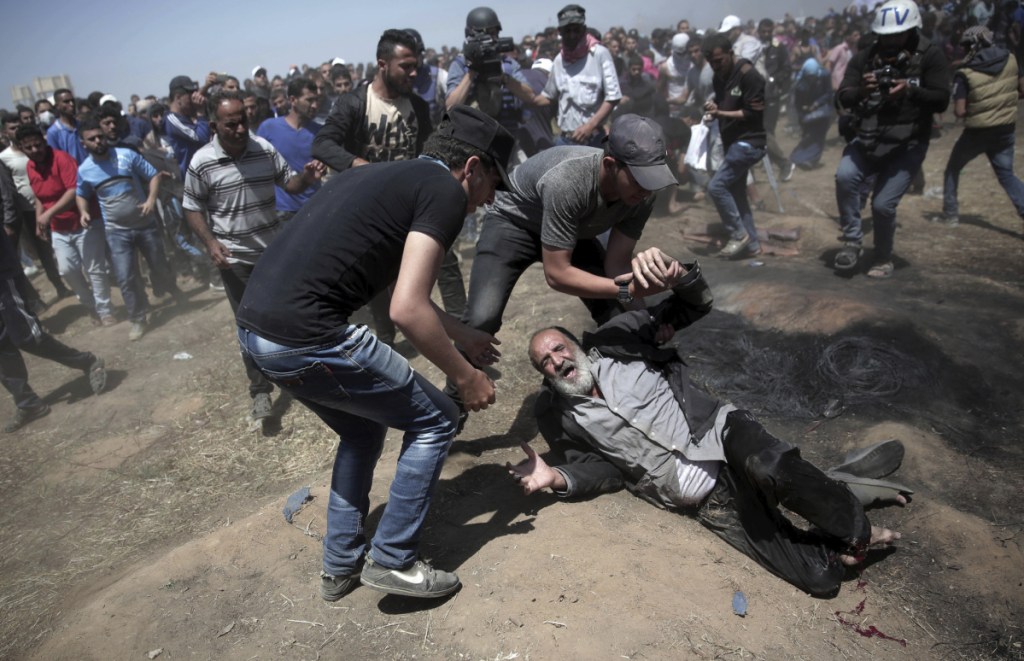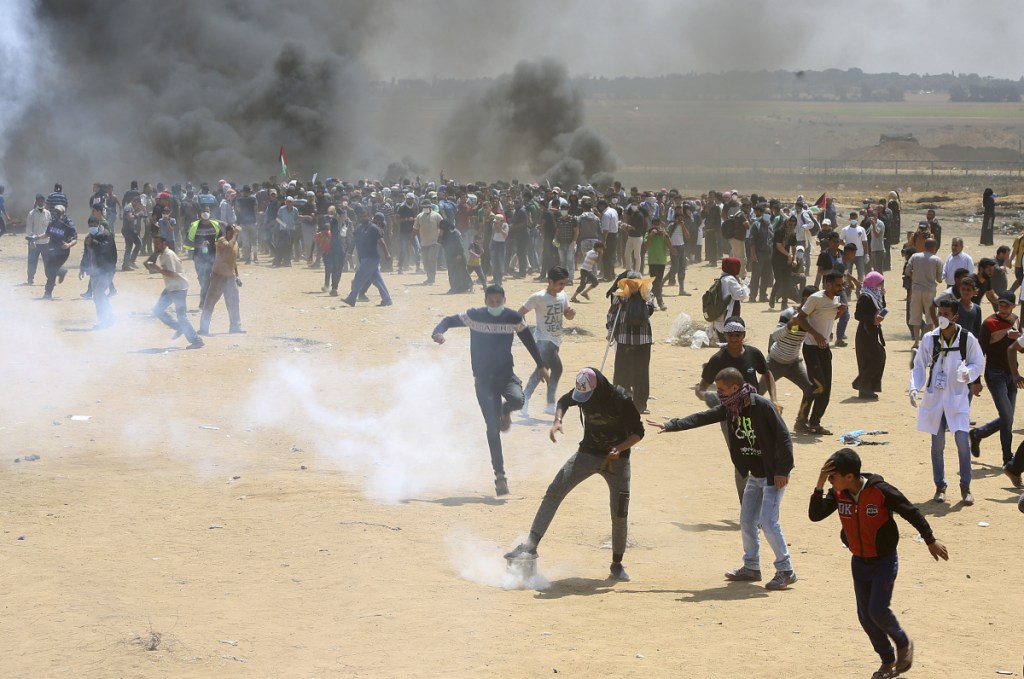ZEITOUN, Gaza Strip — Israeli forces killed 58 Palestinians on the boundary fence with Gaza on Monday, the same day the new U.S. embassy opened in Jerusalem less than 60 miles away.
The death toll more than doubled the number of Palestinians killed during six weeks of demonstrations, dubbed the “March of Return.”
Tens of thousands of Palestinians had gathered on the edges of the fenced-off blockaded territory from mid-morning. Many came to peacefully demonstrate, bringing their children, carrying flags. Food stalls sold snacks and music blared.
But the protests appeared to have a more violent edge than in previous weeks. Some young men brought knives and fence cutters. At a gathering point east of Gaza City, organizers urged protesters over loudspeakers to burst through the fence, telling them Israeli soldiers were fleeing their positions, even as they were reinforcing them.
Israeli snipers were determined not to allow a breach, and ambulances soon began screaming back and forth from the fence, as gunshots rang out over the crowd. No Israeli soldiers were injured, though, and Israel drew widespread condemnation for using excessive force.
More than 2,700 people were injured, according to the Palestinian health ministry in Gaza, including 1,359 from live ammunition. The dead included six children under the age of 18, among them a 15-year-old girl and a medic, the ministry said.
The United Nations said that “those responsible for outrageous human rights violations must be held to account,” and Human Rights Watch described the killings as a “bloodbath.” Palestinian Authority President Mahmoud Abbas condemned the continuing “massacre” of the Palestinian people. Both Turkey and South Africa announced they were recalling their ambassadors from Israel.
The Trump administration, however, blamed Hamas for the loss of life. “The responsibility for these tragic deaths rests squarely with Hamas,” deputy White House press secretary Raj Shah told reporters at a briefing. “Israel has the right to defend itself.”
The violence was a jarring contrast with the opening ceremony for the embassy in Jerusalem, which drew first daughter Ivanka Trump and her husband, Jared Kushner.
Amid the happy bustle of about 800 guests, Kushner spoke, controversial evangelical pastor Robert Jeffress blessed the occasion and President Trump delivered a prerecorded video address, saying that he was still hopeful for peace between Israelis and Palestinians.
The embassy move came despite almost universal criticism from some of the United States’ closest allies in Europe, from Arab nations and from the Palestinians.
The Arab League called a crisis meeting to discuss the “illegal” U.S. Embassy shift, and the 57-nation Organization of Islamic Cooperation called it an “attack on the historical, legal, natural and national rights of the Palestinian people.”
Successive speakers who took the stage at Monday’s ceremony said they firmly believed the embassy move was long overdue and was, in fact, a positive step toward peace.
In his video address, Trump said the move was a long time in coming and added that the “United States remains fully committed to facilitating a lasting peace agreement.”
Kushner, the president’s son-in-law and adviser, echoed those sentiments, saying: “We believe it is possible for both sides to gain more than they give – so that all people can live in peace, safe from danger, free from fear, and able to pursue their dreams.”
For now, the embassy move is mostly symbolic – just the addition of a plaque on the wall of the existing consulate in Jerusalem. Only the ambassador and a core staff will move to Jerusalem during the first phase. And less than $400,000 has been spent so far to increase security and to enable the embassy to start functioning.
Yet the newly chiseled sign has brought with it clear vindication for Israel, which united the western and eastern sides of Jerusalem 51 years ago after its victory in the 1967 Arab-Israeli war.
In the 1980s, Israel formally declared sovereignty over the entire city, including Palestinian neighborhoods. Most countries still refuse to recognize that move and say their embassies will remain in Tel Aviv until Israelis and Palestinians reach a peace agreement.
Speaking at the event, Prime Minister Benjamin Netanyahu said it was a “glorious day.”
“Remember this moment, this is history,” he said. “President Trump, by recognizing history, you have made history.”
GAZA HOSPITAL OVERWHELMED
In Gaza, Hamas has given its backing to the demonstrations, which have galvanized people around a call to protest the loss of Palestinian homes and villages when Israel was formed in 1948.
Palestinians mark that day – known as the “nakba” or “catastrophe” – on Tuesday, when more demonstrations are planned. More than two-thirds of Gaza’s population is descended from refugees who were displaced at the time of Israel’s creation.
At Gaza City’s main al-Shifaa hospital, medics said they were overwhelmed.
“I don’t know how we will manage,” said Ayman al-Sahbani, the head of the emergency department, as families jostled to get in to see injured relatives. “How long can this go on? How long?”
The hospital had set up a new additional 30-bed triage area outside, and earlier in the day said it had the capacity to treat 200 or 300 serious gunshot wounds. It had received around 400 injured by about 6.pm., and most of those had been shot, he said.
“We’ve reached the critical point now,” he said. “A lot of people need operations soon, but the operation room is full.”
Increasing economic hardship has fueled frustrations in Gaza, along with wider despair across Palestinian territories amid moves by the U.S. administration seen as wholeheartedly on Israel’s side of the decades-old conflict.
At least 110 Gazans have been killed over the past six weeks, according to health ministry figures. At the demonstrations east of Gaza, some said the force used by Israel would only bring further unrest.
Standing a few hundred yards from the fence, Nirma Attalah, 29, said her 22-year-old brother had been killed two weeks ago.
“My brother was shot in the head in this place,” she said. She had come Monday with her whole extended family. “We are here for Jerusalem, for Palestinian land,” she said.
A truck rolled past carrying young men chanting: “To Jerusalem we go with millions of martyrs” and “Death rather than humiliation.”
Drones dropped canisters of tear gas, sending crowds fleeing. Other drones dropped leaflets urging demonstrators to stay back from the fence.
“People have come out of the rubble to say we will not forget our rights,” said Yousef Abu Saleh, 25. “The American administration is adopting the Israeli story and stealing our right of return.”
While some said they would abide by official calls to keep the demonstrations peaceful, others talked about their enthusiasm to break into Israel and wreak havoc.
“We are excited to storm and get inside,” said 23-year-old Mohammed Mansoura. When asked what he would do inside Israel, he said, “Whatever is possible, to kill, throw stones.”
Two other young men carried large knives and said they wanted to kill Jews on the other side of the fence.
The Israeli military brought in two extra brigades to the Gaza border in preparation for the demonstrations and added other “defense lines” in an effort to prevent any mass invasion into Israeli communities near the border.
The military said at least 40,000 people protested in 13 different places along the fence – more than twice as many locations as in past weeks of protest.
“Especially violent riots” took place near the southern Gazan city of Rafah,where three people were killed after trying to plant an explosive, the military said. The military also said it would “act forcefully against any terrorist activity,” and it carried out an airstrike on Hamas military posts in northern Gaza after Israeli troops came under fire.
At demonstrations near the Bureij Camp in central Gaza, Ahmed Loulou, 22, released a cluster of balloons carrying a Palestinian flag. In marker he’d written: “We are returning. This is our land.” The load was briefly caught in a power line before bobbing unsteadily toward the border.
He said it was his first time at the demonstrations and he had been persuaded to come by friends.
Meanwhile, young men launched stones from slingshots as they sheltered behind earthen berms. Shortly afterward, the sound of live ammunition zinged through the air over the sound of the afternoon call to prayer.
The vast majority of demonstrators were unarmed, but near a parking area, a man pulled out an AK-47 and took aim at an Israeli drone dropping leaflets. He let off a stream of bullets into the air and brought it down. Later, more gunfire ensued as different Palestinian factions argued over who would keep the downed drown, onlookers said.
Comments are not available on this story.
Send questions/comments to the editors.



